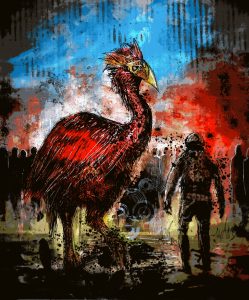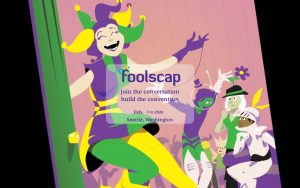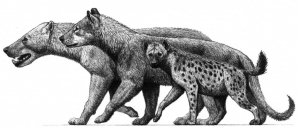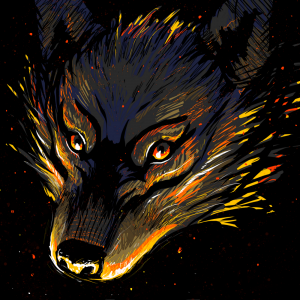An essay by Ellan Vannin, as provided by Arnout Brokking
Art by Luke Spooner
On the day of the race I arrive at the track early, the area already filled with frantic activity.
Down by the kraals, the animal handlers scurry about with oils and ointments and make last minute adjustments to saddle straps and hackamores.
A long line of spectators has begun the trek up the mountain pass in search of a good spot. From down below in camp, I can see them climbing the rocks like one gargantuan snake.
The riders are gathered in the medical tent for examination. All but one. Martin Grimsby is nowhere to be found. If he is not here within the hour, he will not be allowed to start.
~
PRIMIDAY
Once every year, the entire CockatRace community descends upon the Isle of Monapia to test itself against the slopes of Kepler’s Peak.
It is a spectacle like no other and has been the pinnacle of the sport for over a hundred years. But the mountain is unforgiving. Since the first time it was run, two hundred and fifty-two riders have left their lives on the tarmac.
In the coming ten days, I have the opportunity to follow Martin Grimsby, one of the race’s fiercest competitors, as he prepares to take on the mountain.
I am excited to figure out what draws him to the race.
“It’s in my blood,” he tells me when I meet him at his ranch, “Growing up, when we got in trouble, the father of the day made us clean out the cockatrice pens. That’s where it started. Ran my first race when I was thirteen.”

She is a magnificent creature, seventeen hands high. At top speed, her head stretched down to the ground, and her long neck, sleek with feathers, outstretched, balancing on the edge of gravity, she’ll reach one hundred and fifty kilometers an hour.
To read the rest of this story, check out the Mad Scientist Journal: Winter 2020 collection.
Second son in a family of five, Ellan Vannin neither showed the athletic prowess of his sisters, nor the acumen of his elder brother for marrying into a wealthy poly-cule. Instead, bereft of other options, he turned to journalism. “The Edge of Gravity” is his first foray into the fascinating world of cockatrice racing.
Arnout Brokking (1983) is a Dutch writer of SF, fantasy and horror fiction. Arnout believes in the power of story to amaze and inspire, to terrify and delight, and to teach and question. Stories shape both our world and ourselves. He lives in the Netherlands together with his beloved Camilla and Olga and their three children.
Luke Spooner, a.k.a. ‘Carrion House,’ currently lives and works in the South of England. Having recently graduated from the University of Portsmouth with a first class degree, he is now a full time illustrator for just about any project that piques his interest. Despite regular forays into children’s books and fairy tales, his true love lies in anything macabre, melancholy, or dark in nature and essence. He believes that the job of putting someone else’s words into a visual form, to accompany and support their text, is a massive responsibility, as well as being something he truly treasures. You can visit his web site at www.carrionhouse.com.
“The Edge of Gravity” is © 2019 Arnout Brokking
Art accompanying story is © 2019 Luke Spooner



 Back in January 2018,
Back in January 2018, 


